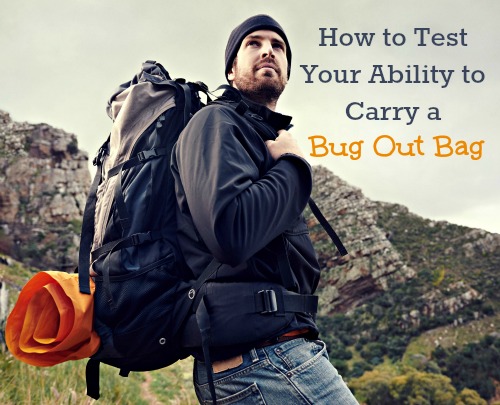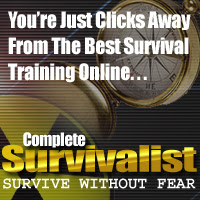How to Test Your Ability to Carry a Bug Out Bag
 By Gaye Levy
By Gaye Levy
A couple of months ago, I posed the question “What is the Baseline of Prepper Fitness?” Although there were varied responses, at the end of the day most everyone agreed that having the ability to walk some distance with a pack of supplies was paramount to survival.
At first blush this may seem contrary to my stance that bugging in is always preferable to bugging out. But what if you are forced to evacuate for safety reasons? History teaches us that homes can be severely damaged or destroyed by earthquakes, tornadoes, floods, wildfires and other errant acts of Mother Nature. Quite often, these disruptive events occur at a moment’s notice, with no warning.
That is when you need to head to the door, grab your Bug Out Bag, and go. This is easy to talk about but the reality is that many of us have not practiced bugging out with a 20- or 30-pound pack on our backs. Could you do it?
In a recent conversation with Dan Sullivan (aka Survival Sullivan), he related his experience testing his own physical endurance during a practice hike while toting a 40-pound pack. He is a youngish guy so I figured that it would be a piece of cake, but nope, it wasn’t.
When I asked him whether I could share his experience on Backdoor Survival, he graciously agreed. Here is one man’s experience and advice for testing your ability to carry a bug out bag.
Testing Your Bug Out Bag
Let’s talk about your bug out bag for a moment… Anyone can blindly add dozens and dozens of survival items thinking:
I’m gonna need this when I bug out… and this, too. And this… and this… because you just never know!
One thing they don’t know, however, is that carrying too much stuff when it’s time to flee is going to be nearly impossible. Heck, heavy backpacks are challenges even for trained military soldiers. I’m willing to bet most preppers won’t be able to walk a single mile with a BOB on their back and they’ll end up ditching some of the equipment or even the entire bag in a survival situation.
Yesterday I decided to test my own and I want to share with you how I did it and some of the lessons that I’ve learned. There’s a gorge 20 miles from me that’s fairly popular (about a mile in length and 800 feet deep), and I decided to go on a small hike with a few friends.
The Goal
The most important thing I wanted to test was not the bag but… myself. I wanted to find out how tired I’d be when I got back. In retrospect, it was better than I expected, I did feel exhausted driving back but that was it. To my surprise, to my amazement, my back didn’t hurt one bit (I actually have back problems from too much sitting in an incorrect position on my laptop). Mission accomplished.
The Preparation
One thing I did was alter the contents of my BOB for this mini-trip. I kept the essentials but took the non-essentials out and replaced them with things such as two more bottles of water and my jacket. I didn’t actually weigh the bag but I’d say it was at least 40 pounds.
The Hike
We left the car near the gorge and started walking on an apparently super-easy trail. I was the only prepper in the group and they didn’t even have equipment as the hike was supposed to be a piece of cake.
We hiked for about 30 minutes before we decided to go back. The first 10 were like a walk in the park but then the trail became rocky, muddy and wet. At some point there was water flowing at our feet and, from that point on, it got narrower and narrower to the point where we had to use hold on to the rocks and safety cords to keep our balance.
The biggest surprise was getting back. This time, the two girls in the group lead the way and I got left behind on more than on occasion. Though I didn’t feel tired, the extra weight forced me to be more careful and watch my step. I almost slipped a couple of times.
 How did this happen? When most preppers try on their fully loaded BOB in their living rooms, they have no idea that, in the real world, they’re going to get tired extremely easy. I’m in decent shape but most of them aren’t and that’s going to be a big problem during a bug out.
How did this happen? When most preppers try on their fully loaded BOB in their living rooms, they have no idea that, in the real world, they’re going to get tired extremely easy. I’m in decent shape but most of them aren’t and that’s going to be a big problem during a bug out.
When we returned, I had to watch in amazement how the two girls in our group moved quicker despite the slippery rocks and I constantly got left behind. In fact, most people we encountered along the way were severely unprepared for this (it was funny to watch them through the eyes of a prepper) and I’m sure that if any of them had my load, they would have had the same problems.
Conclusions
Though everything went according to plan, I plan to increase either the load or the distance next time. I learned a few valuable lessons, which I now want to pass on to you, namely:
· You need to get into shape and hiking is a great way of doing that. It’s a great full-body workout and is a lot more fun than those boring gym exercises. It’s better than running, too, because you don’t grow tired that easily and you can always stop to admire the view.
· You don’t need a heavy bag; you can start with a smaller one and see how that goes. I had it on my back for about an hour and, frankly, I don’t know how many preppers would last this long given that many are out of shape.
· You need proper equipment. In order to avoid slipping or twisting your ankle, you need hiking boots. I know it’s popular nowadays for people to ditch their boots in favor or trainers when it comes to short hikes but in my case, this wasn’t an option. We’re not looking at this from a hiker’s perspective but from a prepper’s perspective.
· Last but not least, if this is the first time you’re testing your BOB, don’t go too far. Remember you have to come back so that’s double the distance. Sure, your bag may be a little lighter when you return because you’ll eat your sandwiches and drink your water but you’ll also grow tired. Don’t overestimate how strong you are unless you’re in shape.
Bottom line: you need to test your B.O.B. Even if you’re planning to bug in, you still need to prepare for the event that you might need to evacuate. One other thing you can do is to increase the level difficulty. Pack more weight in your bag or increase the distance or even the difficulty by taking on a different trail.
Last but not least, do use your survival gear. Get your compass out, see where North is. If you get a minor cut, do use a Band-Aid even if it’s really small. Practice now because when SHTF… it’s going to be too late.
The Final Word
Something I have learned over the years is that you don’t have to be stick-thin to be fit. Quite the contrary. Having a bit of “meat” on your bones in not necessarily a bad thing and can even be an asset when it comes to your ability to transport heavy objects. Keep in mind, though, that having a strong muscle support system is preferable to flab.
In my own case, I have successfully hiked more than a few miles with a 20 pound B.O.B. on board. There is no question that I need to build up my endurance so I can go farther. My goal is ten miles, and then from there, 15 miles. For now, increasing the weight of my pack is not an option.
Testing your ability to carry a Bug Out Bag including how heavy (the pack) and how far (the distance) is a personal decision based upon factors such as age, health, size, and how far you would need to go to find safe shelter. These are questions you should be asking yourself now, well in advance of a disruptive event.
If you need to start with a five-pound pack and one mile, so be it. It is never to late to start and never too late to become PrepperFit! Just stay the course and don’t get discouraged. No one said that prepping was easy but I know for sure that if I can do it, you can too!
Enjoy your next adventure through common sense and thoughtful preparation!
Gaye started Backdoor Survival to share her angst and concern about our deteriorating economy and its impact on ordinary, middle-class folks. She also wanted to become a prepper of the highest order and to share her knowledge as she learned it along the way. She considers her sharing of knowledge her way of giving back and as always, we at Natural Blaze are grateful for her contributions.
If you would like to read more from Gaye Levy, check out her blog at http://www.backdoorsurvival.com/. You can also visit her Facebook page or sign up for updates by email by clicking on Backdoor Survival Updates.

